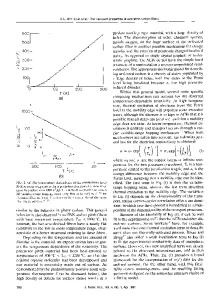Electric Conductive and Mechanical Properties of Fibers Based on Polylactide and Carbon Nanofiber
- PDF / 1,469,128 Bytes
- 5 Pages / 594 x 792 pts Page_size
- 98 Downloads / 401 Views
Fibre Chemistry, Vol. 52, No. 3, September, 2020 (Russian Original No. 3, May-June, 2020)
ELECTRIC CONDUCTIVE AND MECHANICAL PROPERTIES OF FIBERS BASED ON POLYLACTIDE AND CARBON NANOFIBER O. A. Moskalyuk,* K. V. Malafeev,** V. E. Yudin,* A. M. Kamalov,** and E. M. Ivankova**
UDC 620.3: 621.315.592:691.175.2
Using a twin-screw microextruder, fibers based on polylactide and carbon nanofibers (CNFs) were obtained with 4- and 6-fold orientational stretching. The electroconductive and deformation-strength properties of composite fibers were investigated depending on the concentration of the filler and orientational stretch ratio of the polymer. It is shown that with the introduction of low concentrations of CNF (~1 wt%) and with the use of additional high-temperature orientational stretching of the polymer by a factor of 4, it is possible to create composite polylactide fibers with knot-pull tensile strength increased by 20% and with electro-scattering properties.
In the last decade, soft (flexible) electronics have attracted an increasing number of researchers from fields such as materials science, medicine, and electronics engineering. This direction is engaged in the development of soft electronic circuits that can be integrated into living tissues and organs. In the Scopus database, the number of publications on the topic of “soft electronics” has doubled over the past ten years to 2000 articles annually. There are publications that show the possibility of using complex epidermal electronics as chips that measure blood glucose, temperature and other vital signs of organisms [1-3]. Due to the need for direct contact of soft bioelectronics with living organisms, serious requirements are imposed on the materials used in this way. In addition to stable electrically conductive and suitable mechanical properties, biocompatibility is an important requirement [4]. One of the known biocompatible materials is polylactide (PLA), which is also biodegradable, can be processed into various forms, and is sustainably produced on a large scale [5]. The possibility of creating electrically conductive composite materials based on PLA by introducing carbon nanoparticles has been demonstrated in [6]; however, embrittlement of the samples was observed. It is known that materials used for microelectronics (metals, metal alloys, ceramic materials, etc.) have an elastic modulus of tens to hundreds of GPa, while for living tissues it is E0 ~ 10 kPa. Such a difference in the rigidity of materials can lead to injury of body tissues [4]. Therefore, the use of ceramic and metallic materials for creating “soft” bioelectronics is not always advisable, and the use of polymeric materials with electrically conductive properties and lower values of the elastic modulus (polypropylene, polyamide, polyactide, etc.) is the most promising. Thus, the development of electrically conductive composite materials based on biocompatible PLA with the required mechanical properties may turn out to be one of the promising directions in the field of soft electron
Data Loading...











